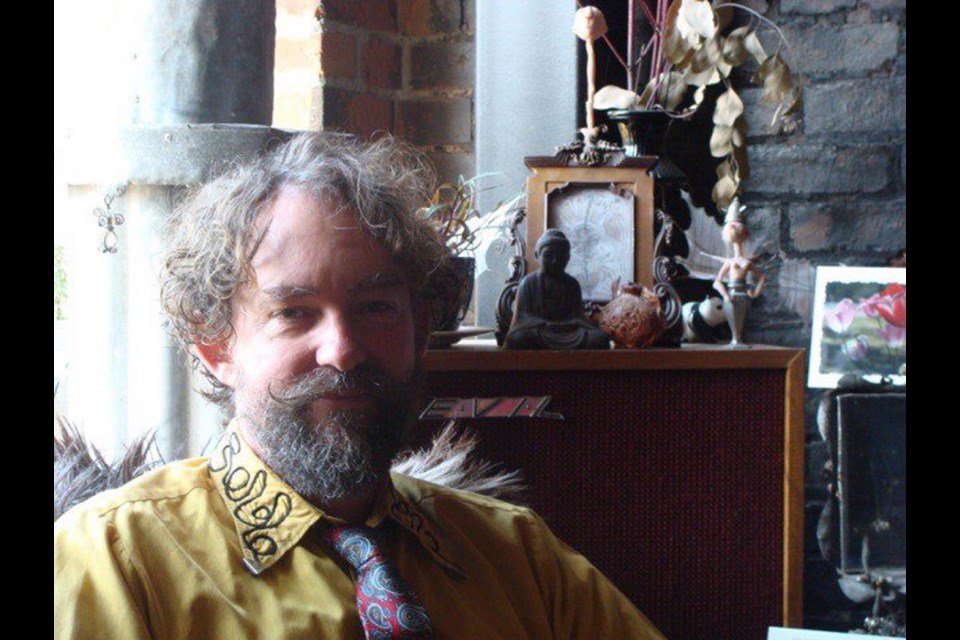You can’t help but be intrigued by the creations of G.J. Pearson.
Wire bent into armatures for wings is covered over with a skin of Japanese paper, lovingly stitched in place with thread. The wings hinge and pivot, flapping in a creaky way when you gingerly turn a loopy crank. The whole is poised atop an antique brass stand, a sort of desktop orrery, a whirligig apparatus from some parallel and slightly out-of-date world.
Pearson is sort of a nutty professor at work, coming up with emotional and esthetic inventions reminiscent of those days before science cornered the market on possible solutions.
“I wouldn’t recommend driving over a bridge I designed,” he jokes. And he looks the part of the steampunk mad scientist — waxed moustache, embroidered shirt collar and long hair with ringlets that match the gothic crockets that drip from every corner of his creations. The feet on his twisted steel candlesticks are truly feet — he’s an expert at artistic soldering — and these feet are likely to be grasping crystal spheres, as an extra embellishment.
He showed me a work in progress. Its crank turns a corkscrew of silver wire which, as it goes around, engages with a sort of pinwheel with cogs. Through a crooked crankshaft, this drives the wings above it, which flank a skull, with a lamp in the brain pan.
The sculpture on the invitation for his current show at Dales Gallery runs by clockwork. You turn the key on a long brass shaft that rises on an angle and pierces the heart of a plaster Jesus (a devotional figure reborn), emerging out of His back to wind the spring of a clockwork motor which, for a few erratic and noisy moments, powers the wings behind Our Lord and Saviour.
Following the devotional motif, he has created a clockwork Christ who rises up to heaven by obvious and rudimentary mechanical means (deus ad machina?). It’s a sort of ferris wheel, and Pearson drew my attention further to the additional power takeoff from the clockwork motor that propels the soft wing beats of the accompanying flight of angels. Yet there’s far more to Pearson’s world than jokey religious skits.
A Victoria native, during a year of fine-art training at the University of Victoria, Pearson was inspired by Roland Brener. At that time, Brener was making Sweeper, a motorized sculpture for the Vancouver Art Gallery.
“I was fascinated by the way he used kinetic elements in his work,” Pearson told me. “Most of the work I find most joy in is the kinetic, working out the puzzles, little motors, cogs, wind-up.”
He seems to linger at the advent of the industrial revolution. Or earlier. “I am interested in doing pieces which will work with heat or air movement.”
Pearson didn’t complete his degree. His deep passion for Renaissance art was at odds with contemporary modes.
“Ugly is the new beautiful when it comes to academic art,” he said. “Maybe not ugly, but complicated, cerebral.”
We agreed that beauty currently seems to be a devalued currency.
This artist admits to many influences.
“I started with Lego,” he recalled. This led to model building and science fiction.
“I was a huge Star Trek fan — the original Star Trek. Every Sunday night, I never missed it.”
Tim Burton’s films, in particular The Nightmare Before Christmas, are another avatar of his gothic-robotic style. But, stylish though it is, his work is about ideas.
“My medium is basically thought. The machines,” he concludes, “are just manifest thought.”
You may see these thoughts clearly in his many drawings. Some he aptly describes as “pages out of children’s book, with no context.” Each, a sort of Brothers Grimm-Edward Gorey mix, has a little poem attached. A new group of ink and gold-leaf illuminations titled Sigils are “two-dimensional representations of a desire, simplified into a statement or a letter.” Spidery and intricate, they might be rendered in wrought iron.
In fact the sign he made for Arrogant Pirate, a quirky shop across Fisgard from Dales in Dragon Alley, is a mix of twisted metal and his sharp paint brush. There are more Pearson mobiles in that shop, and in the past I enjoyed his work in the Fran Willis Gallery and the Barton Leier Gallery. Yet, after years of creative effort, Pearson has no gallery representation beyond our town. It seems to me that, with his children’s books, his anachronistic graphic flair and the irresistible playfulness of his machine/sculptures, he is ripe to be discovered. Video, set design and collaboration on larger projects seem to beckon just over the horizon for a man with such talent and flair.
For now, G.J. Pearson can be your personal discovery. Seek him out.
• • •
Avant Crossing Guards: G.J. Pearson (with watercolours by Denise Nicholls), Dales Gallery, 537 Fisgard St., dalesgallery.ca, 250-383-1552, until July 16.
